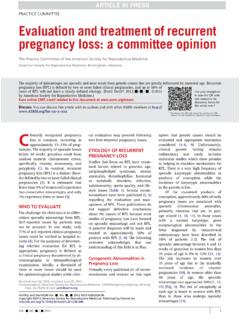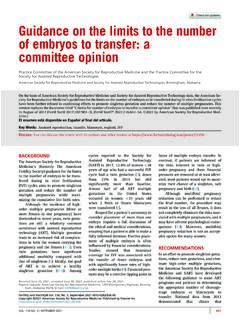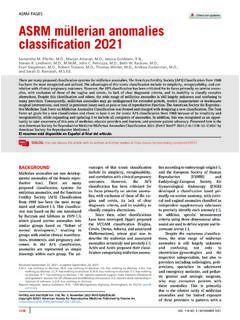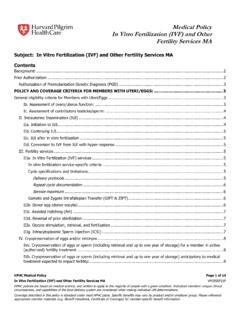Transcription of Guidance regarding gamete and embryo donation
1 Guidance regarding gamete andembryo donationPractice Committee of the American Society for Reproductive Medicine and the Practice Committee for theSociety for Assisted Reproductive TechnologyAmerican Society for Reproductive Medicine and Society for Assisted Reproductive Technology, Birmingham, AlabamaThis document provides the latest recommendations for the evaluation of potential sperm, oocyte, and embryo donors as well as theirrecipients, incorporating recent information about optimal screening and testing for sexually transmitted infections, genetic diseases,and psychological assessments. This revised document incorporates recent information from the US Centers for Disease Control andPrevention, US Food and Drug Administration, and American Association of Tissue Banks, which all programs offering gamete andembryo donation services must be thoroughly familiar with, and replaces the document titled Recommendations for gamete and em-bryo donation : a committee opinion, last published in 2013.
2 (Fertil Steril 2021;115:1395 410. 2021 by American Society for Repro-ductive Medicine.)El resumen est disponible en Espa ol alfinal del art Words:Sperm, oocyte, donor insemination, donor screening, quarantineDiscuss:You can discuss this article with its authors and other readers OF CONTENTSI. IntroductionII. Donors indications, screening, andselectiona. Sperm Donationi. Indications for donor sperminseminationii. Donor sperm screeningiii. Donor sperm selectioniv. Directed (nonanonymous/known) donationv. Quarantine of semenvi. Use of fresh semenb. Oocyte Donationi. Indications for use of donoroocytesii.
3 Oocyte donor screeningiii. Oocyte donor selectioniv. Directed (nonanonymous/known) oocyte donationv. Quarantine of oocytesvi. Requirements of clinicsproviding oocyte donationservicesc. embryo Donationi. Guidance for ART practicesthat offer embryo donationii. Donor embryo screeningiii. Donor embryo eligibilityiv. Situations in which thegamete source was adonor, not an intimatepartnerIII. Management of sperm/oocytedonorsIV. Recipients and their partners screening and testinga. ASRM-recommended evaluationof recipientsb. ASRM-recommended recipientpartner screeningV. Psychoeducational counseling do-nors and recipientsa.
4 ASRM-Recommended Psycho-educational Counseling Donorsb. Psychoeducational Consultation: gamete donation Recipients(Oocytes, Sperm, and Embryos)c. Psychoeducational Consultation: gamete (Sperm and Oocyte) donation with a Directed Donord. Psychoeducational Consultation: embryo donation with a DirectedDonorVI. Genetic screening and counseling donors and recipientsa. Genetic Carrier Screening forHeritable Diseasesi. Recommended non-iden-tified (anonymous) donorcarrier screeningii. Donor counselingiii. Donor eligibilityiv. Recipient counselingb. Family History Screening forNon-Identified (Anonymous)Donorsi.
5 Recommended donor fam-ily history screeningii. Donor counselingiii. Non-identified (anony-mous) donor Recipient counselingVII. Legal considerations donor andrecipientsVIII. FDA donor eligibility question-naire, physical exam, laboratorytestingReceived January 20, 2021; accepted January 26, 2021; published online April 8, requests: American Society for Reproductive Medicine, 1209 Montgomery Highway, Birming-ham, AL 35216 and Sterility Vol. 115, No. 6, June 2021 0015-0282/$ 2021 American Society for Reproductive Medicine, Published by Elsevier 115 NO. 6 / JUNE 20211395 ASRM PAGESa. FDA Donor Eligibility Medical Questionnaireb.
6 FDA Donor Eligibility Laboratory Testingi. Managing laboratory resultsc. FDA Donor Eligibility Physical ExamIX. ReferencesI. INTRODUCTIONThe use of sperm, oocyte, and embryo donation services hasincreased over the past several decades (1 3). Theavailability of donor gametes provides individuals andcouples who otherwise may not be able to conceive with anopportunity to build a family. To optimize safety andoutcomes, the US Food and Drug Administration (FDA),American Association of Tissue Banks, US Centers forDisease Control and Prevention (CDC), and AmericanSociety for Reproductive Medicine (ASRM) have developedtheir own Guidance for the screening of donor tissue document aims to summarize the current guidancefor donor eligibility determination that has been mandatedby FDA before the use of donor oocytes, sperm, or are defined as individuals who are not sexually inti-mate partners of the recipients.
7 Donor eligibility determina-tion is required for donor sperm, donor oocytes, donorembryos, and sperm and oocyte sources when planning touse a gestational carrier. This Guidance also reviews thescreening of donors and recipients that has been recommen-ded by CDC and ASRM. Although FDA donor eligibility deter-mination focuses on infectious risk, the ASRM Guidance alsoincorporates prenatal optimization, psychoeducational coun-seling of donors and recipients, and genetic risk Guidance for the screening and testing of gamete andembryo donors applies to all potential donors in the UnitedStates. Because the prevalence of sexually transmitted infec-tions (STIs) may vary in other locales, this Guidance may notbe appropriate for other countries or individuals who come tothe United States from other countries.
8 If a donor is deemed ineligible based on the FDA Guidance detailed herein, thetissue cannot be used for a non-identified (anonymous) dona-tion. However, for a directed or known donation , the ineli-gible tissue may be used if both parties are aware of thetheoretical infectious or genetic risk and consent to move for-ward with the this document, anonymous donors havebeen referred to as non-identified. The transition in lan-guage from anonymous to non-identified reflects therealization that anonymity is decreasing with the prevalenceof and access to nonmedical genetic donation , and thereby this document, does notapply to lesbian couples who undergo reciprocal in vitrofertilization (IVF), in which one partner provides the oocyte(s)and the other partner carries the pregnancy.
9 In this setting, thepartner does not donate her oocytes. The oocytes should beconsidered shared between sexually intimate partnersbecause sperm is shared between heterosexual couples, pre-sumed to be sexually FDA does not require screening or testing of therecipients of donated gametes, ASRM recommends the evalu-ation of recipients as described. other areas where the ASRM recommendations may be more stringent than the FDA min-imum requirements are noted herein. Additionally, state re-quirements may be more restrictive than those of FDA, andclinics are encouraged to check with government officials inthe state where their practice is located to determine minimumscreening and testing requirements for their promulgation of FDA regulations has caused consid-erable oversight of gamete and embryo donation , includingmandatory registration of all assisted reproductive technol-ogy (ART)
10 Programs with the federal government, federal in-spections of programs that perform donation , requireddocumentation, and written protocols related to donorscreening, testing, selection, rejection, and follow-up. Com-plete records of all donor cycles, including the documentationof adherence to FDA regulations, must be made available toFDA inspectors at their request. Federal regulations andfrequently asked questions and answers may be viewed atthe following websites: DONORS INDICATIONS, SCREENING, ANDSELECTIONa. Sperm DonationDonated sperm for use for donor insemination (DI) or IVF maybe performed with directed (known) or non-identified (anon-ymous) donors depending on clinical circumstances.








